#Wildlife of South Georgia
Explore tagged Tumblr posts
Text
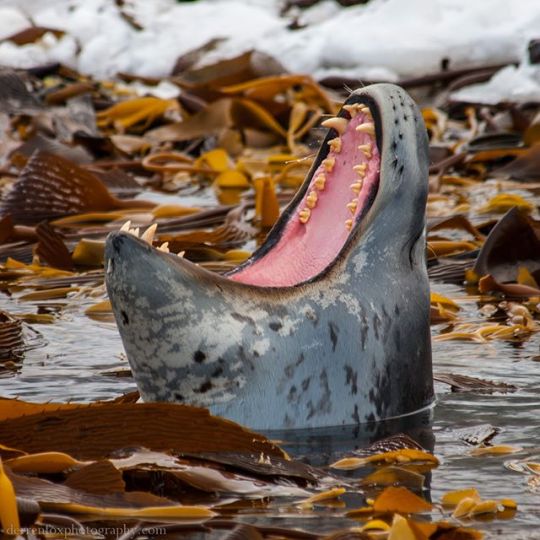
A leopard seal (Hydrurga leptonyx) emerges from the kelp on Bird Island, South Georgia
by Derren Fox
#leopard seal#hydrurga leptonyx#seals#pinnipeds#hydrurga#phocidae#pinnipedia#carnivora#mammalia#chordata#wildlife: south georgia#wildlife: antarctica
13K notes
·
View notes
Text

Elephant seal bulls fight for mating rights at Saint Andrews Bay in South Georgia.
PHOTOGRAPH BY PAUL NICKLEN, NATIONAL GEOGRAPHIC CREATIVE
#paul nicklen#photographer#national geographic#elephant seal bulls#seal#saint andrews bay#south georgia#animal#mammal#wildlife#nature
17 notes
·
View notes
Text
" South Georgia " //© Mathias Koch
Music: © Thomas Newman - Any Other Name
#South Georgia#Sandwich Islands#South Atlantic Sea#United Kingdom#nature#landscape#Coast#Shoreline#Wildlife#Birds#Penguins#4K#8K#12K#fpv#reels#aesthetics#wanderlust#explore#follow#discover
63 notes
·
View notes
Text

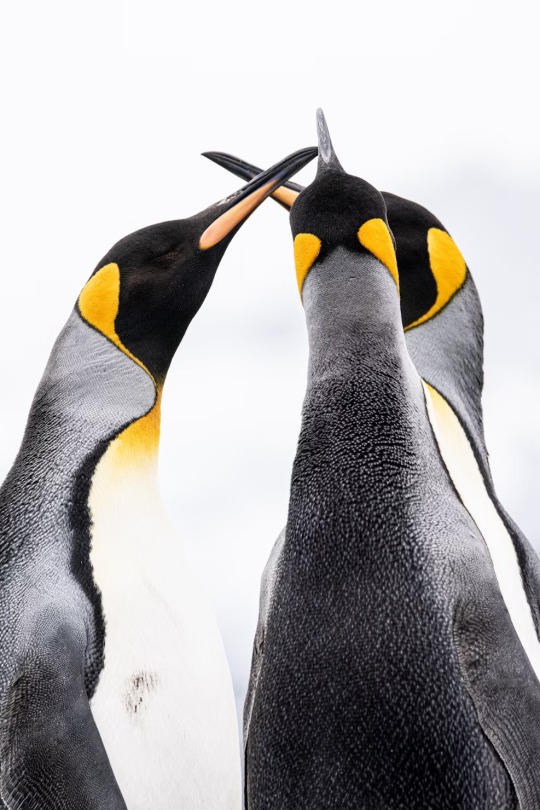

King Penguins in South Georgia and the South Sandwich Islands (British Overseas Territory)
Birger Strahl
Scientific name: Aptenodytes patagonicus
Conservation status: Least Concern (Population increasing)
Mass: 21 – 38 lbs
Family: Spheniscidae
Class: Aves
Domain: Eukaryota
Genus: Aptenodytes
The king penguin is the second largest species of penguin, smaller, but somewhat similar in appearance to the emperor penguin. There are two subspecies, A. p. patagonicus and A. p. halli; patagonicus is found in the South Atlantic and halli in the South Indian Ocean and at Macquarie Island.
#Antarctica#South Georgia and the South Sandwich Islands#British Overseas Territory#British Overseas Territories#British Territory#King Penguins#King Penguin#Penguins#Penguin#Wildlife#AntarcticaWildlife#Birds#Bird
3 notes
·
View notes
Text
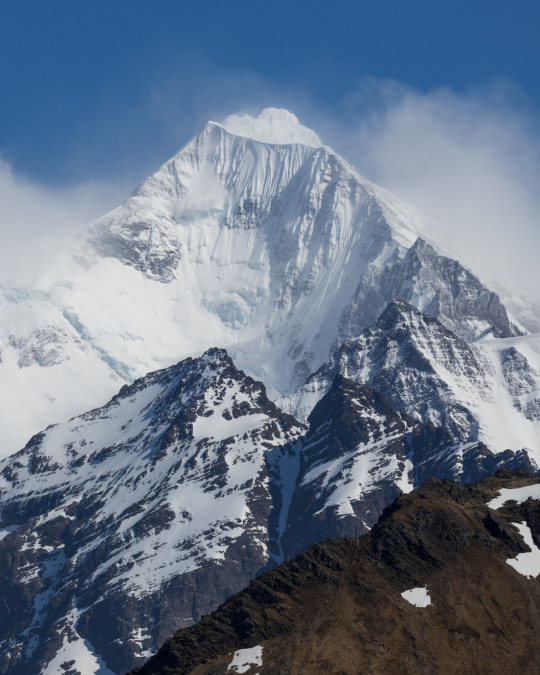
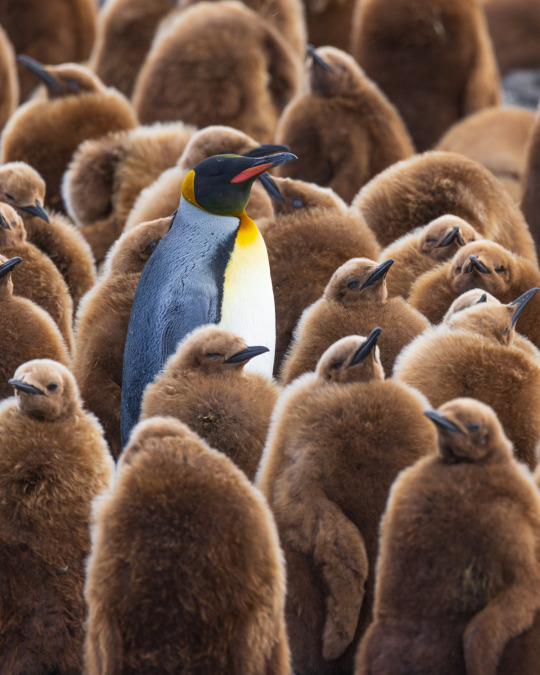

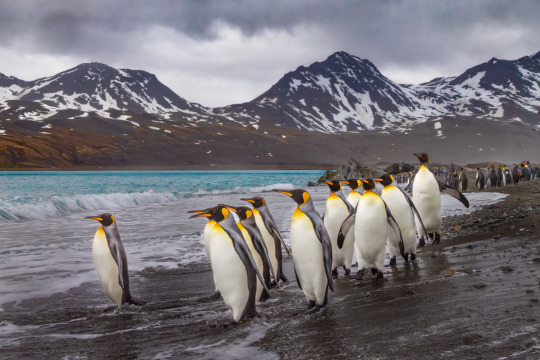
One of the most amazing natural locations in the world - South Georgia Island in the South Atlantic.
📸 by Richard Bernabe
#Richard Bernabe#Penguins#South Georgia Island#South Atlantic#Amazing#Wildlife#Beautiful#Nature#Travel#Adventure#Photography
5 notes
·
View notes
Text
Cane/Bamboo Adventures Part 1/?
So we just moved into a new house and there's this huge thing in the very back of the yard along a creek that I thought was bamboo, then I thought it was cane, and then after checking as many cane ID posts and videos I could find, I'm still completely unsure. My friend who's a wildlife student says it doesn't look like bamboo to her, but we both agree it doesn't look like the cane we've seen around South Georgia. She said it must be Arundinaria gigantea because no other cane gets this large, but all the cane we've seen identified as A. gigantea doesn't look like this. Here's my notes and some pics.
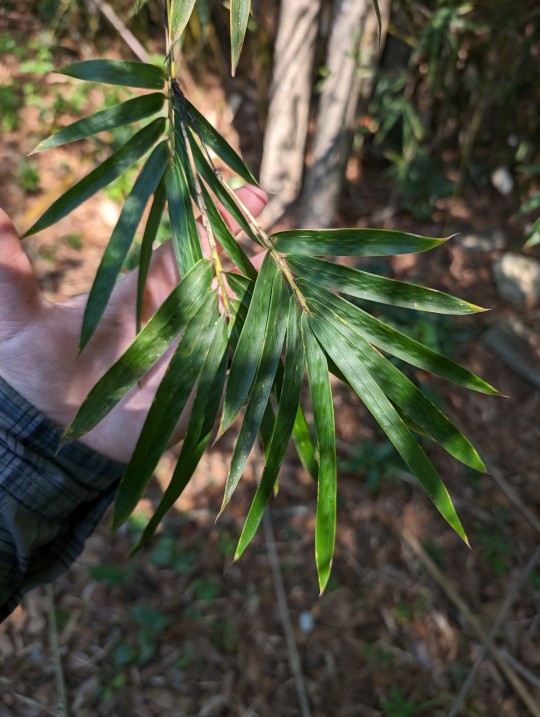
First, the leaves are much smaller than cane I've seen around here. Even very small, young cane around here has leaves about the length of my forearm.
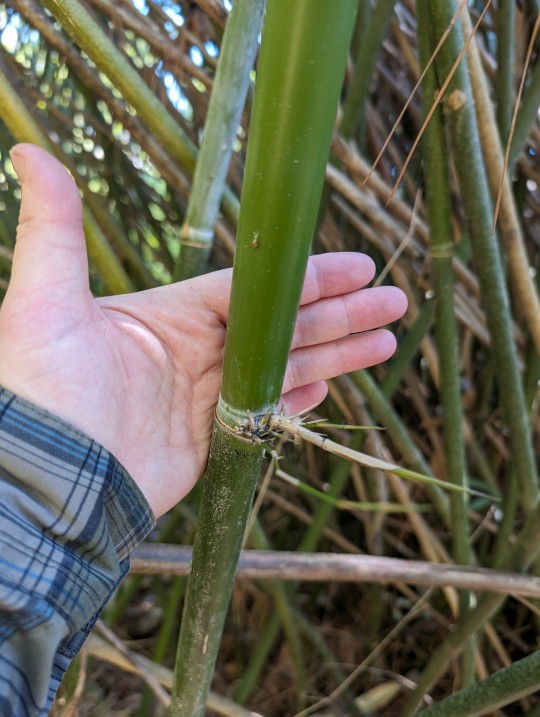
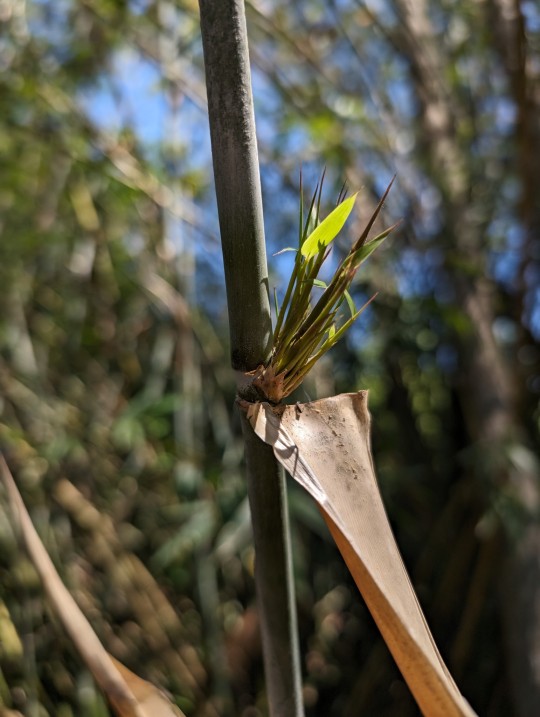
Second, a couple things online I found distinguishing bamboo from cane say that new bamboo branches grow outward, while cane grows more upward. However there seems to be both upward and outward shoots on this bunch (examples of both pictured above). Also worth noting, the picture above on the left is the biggest diameter branch I found. I have relatively small hands for context (I wear small-medium sized gloves).
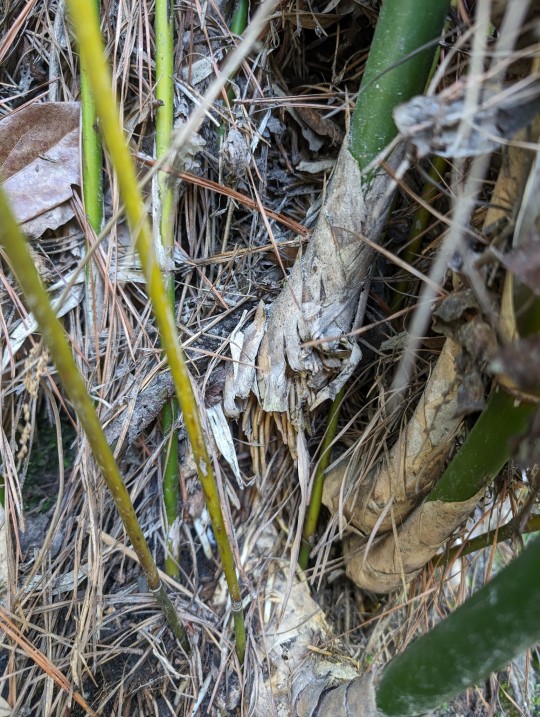
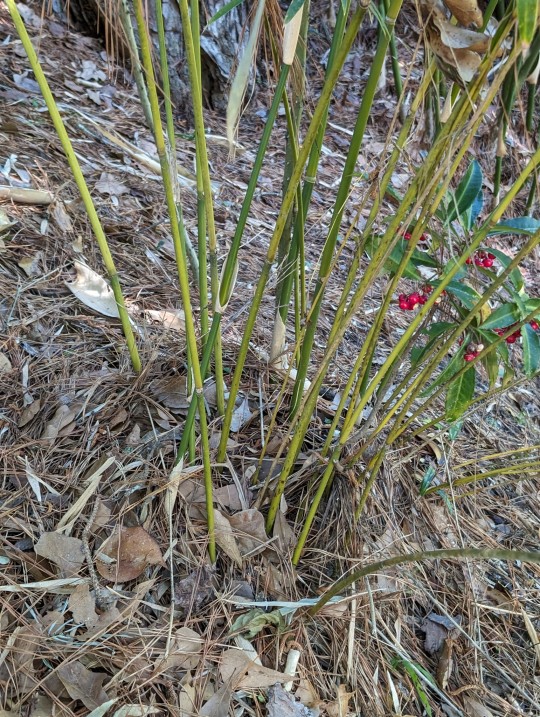
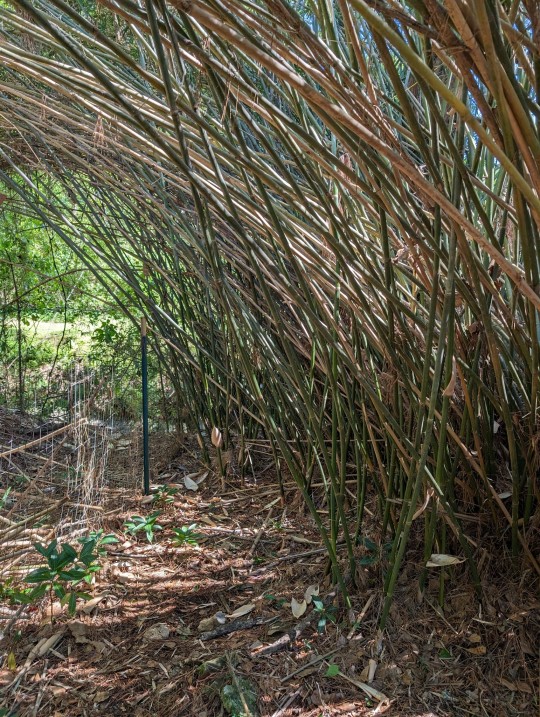
Then here's just some more pictures. I crawled down into a creek for the root picture (left)(a steep 7 foot drop haha). The middle picture is the youngest bunch I found, again it doesn't resemble cane I've seen around here. The picture on the right is a further away picture after I cleared some dead branches.
Also worth noting, this is tucked behind a house, between a fence, a creek, and like 3 trees. So it doesn't have a ton of space to grow, and I'm guessing that's why it's so dense.
If anyone happens to know anything about this please let me know! A week or so ago I emailed a guy from NC State and uploaded it on inaturalist, but I haven't received any replies or ID 😭
#I'm working on clearing out all the dead branches currently to give it more space#native plants#bamboo#cane#river cane#plant identification#plant ID#arundinaria gigantea#?#solarpunk
292 notes
·
View notes
Text

The government of the South Georgia and South Sandwich Islands (SGSSI), which operates as a British overseas territory, recently announced that it had established new no-fishing zones over 166,000 km² (64,100 mi²) of its existing marine protected area, and prohibited krill fishing in an additional 17,000 km² (6,600 mi²) of the MPA.
These new no-fishing zones were established to protect krill-dependent marine wildlife, including baleen whales and penguins, while also considering the fisheries operating in the area, which target krill and other species.
While conservationists initially pushed for further protections, they ultimately accepted the decision, with one calling it a “positive and good outcome.”
However, Argentina, which claims the South Georgia and South Sandwich Islands as part of its Tierra del Fuego province, has expressed its dissatisfaction with the SGSSI government’s decision.
#good news#environmentalism#science#environment#nature#animals#conservation#marine life#marine biology#ocean life
324 notes
·
View notes
Text

12 June 2024
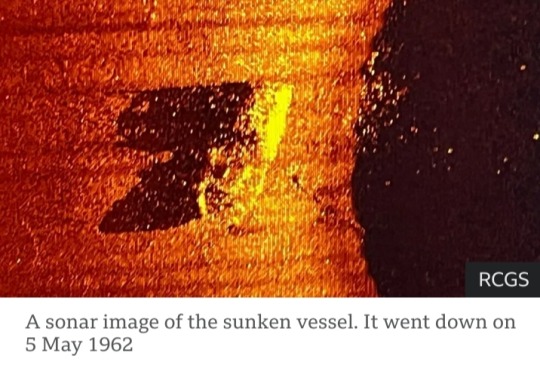
Wreck hunters have found the ship on which the famous polar explorer Ernest Shackleton made his final voyage.
The vessel, called "Quest," has been located on the seafloor off the coast of Newfoundland, Canada.
Shackleton suffered a fatal heart attack on board on 5 January 1922 while trying to reach the Antarctic.
And although Quest continued in service until it sank in 1962, the earlier link with the explorer gives it great historic significance.
The British-Irish adventurer is celebrated for his exploits in Antarctica at a time when very few people had visited the frozen wilderness.
"His final voyage kind of ended that Heroic Age of Exploration, of polar exploration, certainly in the south," said renowned shipwreck hunter David Mearns, who directed the successful search operation.
"Afterwards, it was what you would call the scientific age. In the pantheon of polar ships, Quest is definitely an icon," he told BBC News.
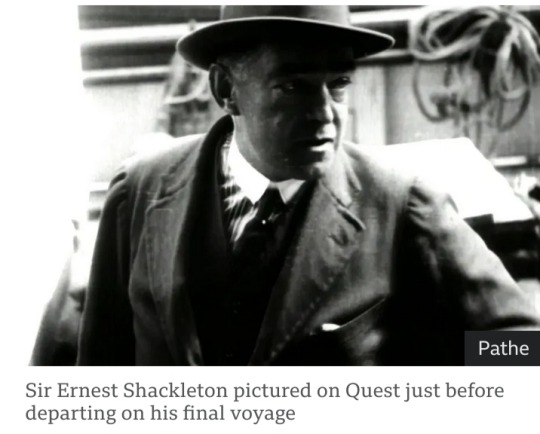
The remains of the ship, a 38m-long schooner-rigged steamship, were discovered at the bottom of the Labrador Sea on Sunday by a team led by The Royal Canadian Geographical Society (RCGS).
Sonar equipment found it in 390m (1,280ft) of water. The wreck is sitting almost upright on a seafloor that has been scoured at some point in the past by the passing of icebergs.
The main mast is broken and hanging over the port side, but otherwise, the ship appears to be broadly intact.
Quest was being used by Norwegian sealers in its last days. Its sinking was caused by thick sea-ice, which pierced the hull and sent it to the deep.
The irony, of course, is this was the exact same damage inflicted on Shackleton's Endurance - the ship he used on his ill-fated Imperial Trans-Antarctic Expedition of 1914–1917.
Fortunately, the crews of both Endurance, in 1915, and Quest, in 1962, survived.
Indeed, many of the men who escaped the Endurance sinking signed up for Shackleton's last polar mission in 1921-1922, using Quest.

His original plan had been to explore the Arctic, north of Alaska, but when the Canadian government withdrew financial support, the expedition headed south in Quest to the Antarctic.
The new goal was to map Antarctic islands, collect specimens and look for places to install infrastructure, such as weather stations.
Shackleton never made it, however, struck down by heart failure in the Port of Grytviken on the British Overseas Territory of South Georgia, the last stop before reaching the White Continent. He was just 47 years old.
After his death, Quest was involved in other important expeditions, including the 1930-31 British Arctic Air Route Expedition led by British explorer Gino Watkins, who himself tragically died aged 25 while exploring Greenland.
Quest was also employed in Arctic rescues and served in the Royal Canadian Navy during WWII, before being turned over to the sealers.

The RCGS team members carried out extensive research to find Quest's last resting place.
Information was gathered from ship's logs, navigation records, photographs, and documents from the inquiry into her loss.
The calculated sinking location in the Labrador Sea was pretty much spot on, although the exact co-ordinates are being held back for the time being.
A second visit to the wreck, possibly later this year, will do a more complete investigation.
"Right now, we don't intend to touch the wreck. It actually lies in an already protected area for wildlife, so nobody should be touching it," associate search director Antoine Normandin said.
"But we do hope to go back and photograph it with a remotely operated vehicle, to really understand its state."
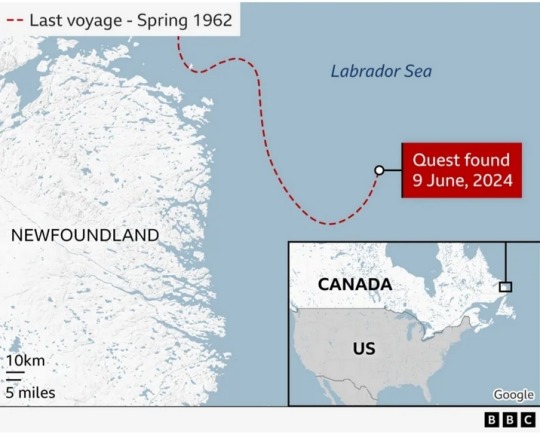
Alexandra Shackleton is the explorer's granddaughter and was patron to the RCGS survey.
"I was thrilled, really excited to hear the news; I have relief and happiness and a huge admiration for the members of the team," she told BBC News.
"For me, this represents the last discovery in the Shackleton story. It completes the circle."
The explorer continues to spark interest more than a century after his death.
Hundreds of people visit his grave on South Georgia every year to pay their respects to the man known by his crews simply as "The Boss."
"Shackleton will live forever as one of the greatest explorers of all time, not just because of what he achieved in exploration but for the way he did it, and the way he looked after his men," said David Mearns.
"His story is timeless and will be told again and again; and I'm just one of many disciples who'll keep telling it for as long as I can."

—
Sir Ernest Henry Shackleton CVO OBE FRGS FRSGS (15 February 1874 – 5 January 1922) was an Anglo-Irish Antarctic explorer who led three British expeditions to the Antarctic.
He was one of the principal figures of the period known as the Heroic Age of Antarctic Exploration.
#Ernest Shackleton#Quest#Newfoundland#Canada#Antarctic#polar explorer#shipwreck hunter#shipwreck#Labrador Sea#The Royal Canadian Geographical Society (RCGS)#Endurance#1930-31 British Arctic Air Route Expedition#Gino Watkins#sonar instrument#Heroic Age of Antarctic Exploration#Sir Ernest Henry Shackleton#British expeditions
65 notes
·
View notes
Text
‘Flock of bears’ investigates water bowl outside Florida home. See them snoop
The Georgia native said she didn’t know they would encounter so much wildlife when they moved south, but now it’s one of her favorite things about their home.
“I just want to say that I absolutely love it; it’s scary and beautiful at the same time,” Palmer-Cobb said. “There is nowhere else that I would rather live!”
37 notes
·
View notes
Text

A group of Gentoo penguins (Pygoscelis papua) porpoising in South Georgia
by Gregory "Slobirdr" Smith
#gentoo penguin#penguins#birds#pygoscelis papua#pygoscelis#spheniscidae#sphenisciformes#aves#chordata#wildlife: south georgia
112 notes
·
View notes
Text
"After teetering on the edge of extinction almost 50 years ago, the wood stork is now widespread across the southeastern US, and is preparing a flight off the Endangered Species List (ESL).
It’s all in a day’s work for the ESL, the world’s most successful conservation program in history, and the only stork native to North America is just the most recent beneficiary.
The wood stork faced extinction when listed in 1984 under the Endangered Species Act. The population had decreased from 20,000 nesting pairs to less than 5,000 pairs, primarily nesting in south Florida’s Everglades and Big Cypress ecosystems.
The recovery program worked to restore and protect the ecosystems which the four-and-a-half-foot-tall bird calls home.
Today, the wood stork breeding population has doubled to 10,000 or more nesting pairs and increased its range, including the coastal plains of Mississippi, Alabama, Florida, Georgia, and the Carolinas. These long-legged wading birds more than tripled their number of nesting colonies from 29 to 99 in their expanded range.
US Fish and Wildlife explained they’ve adapted to new nesting areas, moving north into coastal salt marshes, old, flooded rice fields, floodplain forest wetlands, and human-created wetlands.
The Fish and Wildlife Service will take comments on the proposal through April 17th, and even if it is delisted, it would remain a protected species under other legislation such as the Migratory Bird treaty...
“The wood stork is recovering as a result of protecting its habitat at a large scale,” said Assistant Secretary for Fish and Wildlife and Parks Shannon Estenoz. “This iconic species has rebounded because dedicated partners in the Southeast have worked tirelessly to restore ecosystems, such as the Everglades, that support it.”"
-via Good News Network, 2/20/23
#endangered species act#endangered species#biodiversity#conservation#conservation news#everglades#georgia#florida#united states#wetlands#ecosystem restoration#ecosystem#good news#hope
195 notes
·
View notes
Text
Moth of the Week
Hummingbird Clearwing Moth
Hemaris thysbe
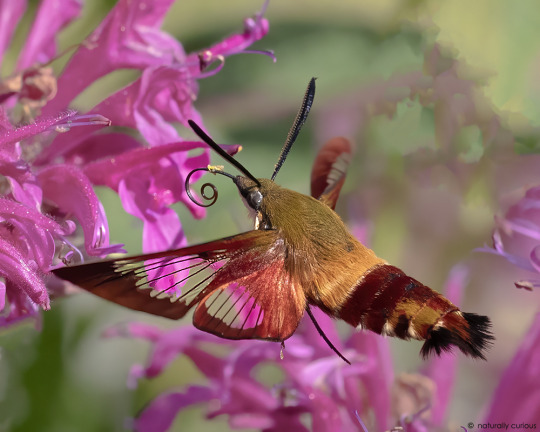
The hummingbird clearwing moth is a part of the family Sphingidae or the hawkmoth family and was first described by Johan Christian Fabricius in 1775. The name Hemaris Thysbe is thought to be a reference to Thisbe, one of the doomed lovers in Ovid's Metamorphoses, due to the color of Thisbe’s blood-stained scarf and the maroon color of the moth. Additionally, the name hummingbird clearwing is due to the humming noise created by the rapid flapping of the moth’s transparent wings.
Description The hummingbird clearwing moth typically has an olive green and maroon back with a white or yellow and maroon underside. It has pale legs and no stripes, which is how you tell this moth apart from other in its genus, Hemaris. Its wings are transparent with a maroon border. After hatching, the hummingbird clearwing’s wings are a fully opaque dark red to black. Then the wing’s scales fall off when the moth takes flight, resulting in a clear wing with maroon borders and visible veins. However, a moth’s color and wing patterning varies between individual moths. For example, moths born in the south or later in the mating season are darker in color, and different populations have varying wing border shapes.
Average wingspan of 4.75 cm (≈1.9 in)
Up to 70 wingbeats per second
Can fly up to 12 mph (≈19.3 kph)
Diet and Habitat When in their caterpillar stage, these moths eat the leaves of cherry trees, European cranberry bushes, hawthorns, dogbane, honeysuckle, and snowberry bushes. Adult hummingbird moths feed on the nectar from flowers such as the Wild Bergamot and beebalm, red clovers, lilacs, phloxs, snowberry, cranberry, blueberry, vetch and thistle. The hummingbird clearwing prefers purple and pink flowers. They use their long proboscis or feeding tube to collect nectar from the flowers while flying in front of it like a hummingbird.
The average proboscis is 20 mm (≈0.8 in)
These moths are the most common in southern Ontario and the eastern United States. Their habitat ranges from Alaska to Oregon in the west and from Newfoundland to Florida in the east. They migrate northward from April to August and southward in late spring and the fall. They inhabit forests, meadows, and suburban gardens.
Mating The hummingbird clearwing has two broods a year in the south, but only one in the north. Mating takes place in May and June as females attract males with pheromones produce from glands at the tip of the abdomen. Female hummingbird moths will lay 200 eggs that will hatch in only 6 to 8 days.
Predators Hummingbird moths and caterpillars in general are hunted by birds, mantids, spiders, bats. To help protect themselves, these types of moths resemble hummingbirds or bees to fool predators.
Fun Fact Adults hummingbird clearwing moths are most active during the hottest parts of the day and have no hearing abilities due to a lack of “hearing organs.”
(Source: Wikipedia, Life On CSG Pond, United States Department of Agriculture, Georgia Wildlife Federation, Beyond Pest Control)
#animals#bugs#facts#insects#libraryofmoths#moth#mothoftheweek#lepidoptera#Sphingidae#hummingbird clearwing moth#Hemaris thysbe
118 notes
·
View notes
Text
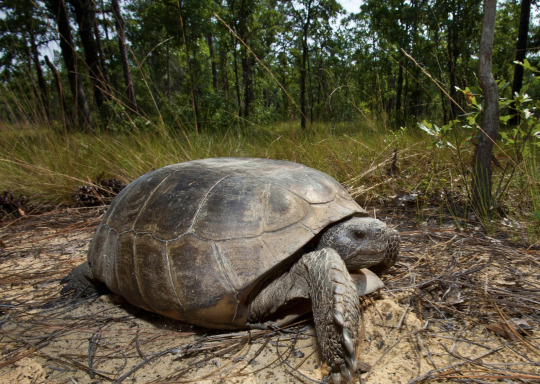
Excerpt from this story from WTSP:
New research is showing that the majority of gopher tortoises could be at risk of extinction in less than 80 years.
According to a study from the Center for Biological Diversity, a new model that details population viability for the tortoises predicts that less than 1% of the species will be around by the year 2100.
This comes after a previous model was discovered to have several errors and overestimated future tortoise populations. It stated that 67% would be around in the same time period.
The flawed model was used so the U.S. Fish and Wildlife Service could deny the species protections from the Endangered Species Act back in 2022, the study explains.
“The previous model was far too flawed to use as a basis for decision making,” said Kevin Shoemaker, Ph.D., a professor of population ecology, in a statement. “I hope the Service does the right thing and re-evaluates their decision. In the meantime, researchers should move quickly to develop a more realistic model to support conservation decisions for this ecologically important species.”
Other errors discovered in the model include a movement of gopher tortoises that produced an "inadvertent positive feedback loop," indicating that the populations were growing faster than biologically possible.
The study also learned the previous model accelerated the rate of sexual maturation of younger gopher tortoises, causing inflated population growth predictions.
“Demographic models are powerful predictive tools for wildlife management decisions, but it’s critical that they be constructed correctly and that the parameters are based on sound scientific data. Unfortunately, the original model that was used to predict the future survival of gopher tortoise populations was significantly flawed and resulted in an erroneous decision by the Service,” said Matthew Aresco, Ph.D., biologist and board member at Nokuse Education, Inc, in a statement.
Researchers explain that the U.S. Fish and Wildlife Service denied protections from the Endangered Species Act for gopher tortoise populations in Florida, Georgia, South Carolina and most of Alabama. Tortoises in Louisiana, Mississippi and western Alabama were allowed protections.
4 notes
·
View notes
Text
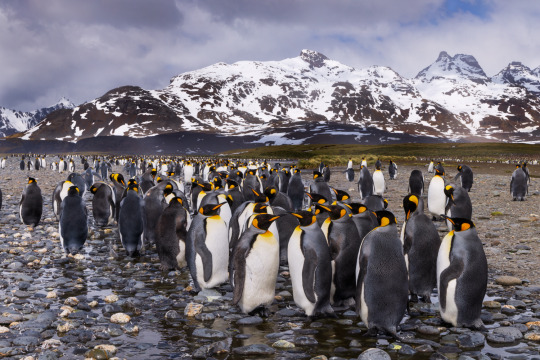
"A Formal Occasion" South Georgia Island by Richard BernabeNew cover photo on Richard's Website: richardbernabe.com
1 note
·
View note
Note
If you put a bunch of horses, zebras and donkeys in a large field together, with enough grass, vegetation, water, etc. to consume but without any human intervention - would there be interbreeding going on? If not, what do you think this scenario would look like more generally? Thanks in advance :)
This is a fun question! I know folks have said "absolutely not" to this question before, but I am going to go against the grain and say there would be!
My evidence starts with the Twin Peaks Herd Management Area in California - this is one of the few HMAs that has both horses and burros in the same area and it ALSO has mules pop up from time to time:

In 2010, there was a round-up of 1,800 equids; 180 or so were burros, and almost 20 were mules! You can read more about this HMA here.
I've seen a few of these pop up - including at one of the recent Internet Adoptions, and through a Mustang nonprofit.
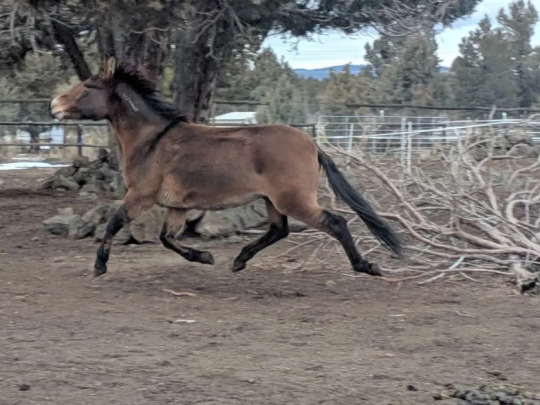
So! Horses + donkeys = yes, in the wild! Not often, but it happens. These are a male donkey and a female horse - hinnies, with a female donkey and a male horse, are a lot less common in general, and I don't know of any wild occurrences.
The second part of this is zebroids, or zebra hybrids. Zorses do sometimes happen in captivity, but not often. Zedonks are a more common 'accidental' cross - reported in the Colchester Zoo in England. This was a male zebra and a female donkey:
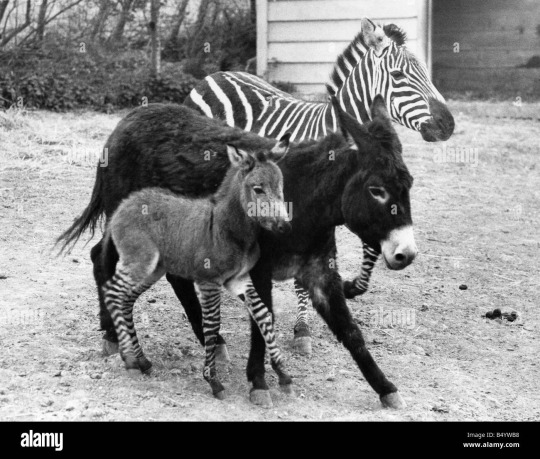
Zebra-Donkey hybrids have popped up a few times in captivity, including at the Chestatee Wildlife Preserve in Georgia, in 2010. She was similarly born to a female donkey and male zebra. The preserve's founder said that the animals had been running in the same large fields for more than 30 years and never had any crossbreeding until 2010!
Safari Eco Park, in Barbados, has a zedonk that came from a female zebra and male donkey in 2005: "Burchell's Zebra named Allison produced a zonkey called Alex sired by a donkey at Highland plantation in the parish of Saint Thomas, Barbados. Alex, born April 21, 2005, is apparently the first zonkey in Barbados."

I have heard that zonkeys occur in the wild in South Africa between male zebras and female donkeys, but I cannot actually find much proof. There was a wild Zonkey filmed in 1999 along Hennops Offroad Trail outside of Pretoria South Africa, and then another spotting and recording in 2014.
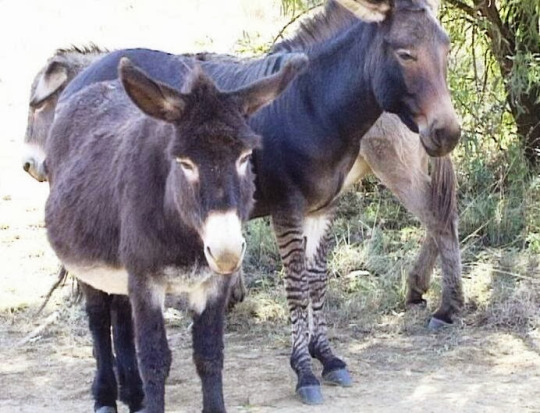
This means that zebra + donkey = yes as well!
Given all this, my answer is that hybrids are a definite possibility in this scenario, if not super likely. They would likely be zedonks and mules rather than zorses though.
18 notes
·
View notes
Text
Holidays 11.13
Holidays
Actor’s Day
Advocacy Action Day
Blame Someone Else Day
Brassiere Day
Canterbury Day (New Zealand)
Caregiver Appreciation Day
Day of Radiological, Chemical and Biological Defense Troops (Russia)
Geographic Information Systems Day
International Day of Huntington’s Disease
International Schinzel-Giedion Syndrome Awareness Day
Lhabab Duechen (Bhutan)
Madder Day (French Republic)
Mister Rogers Cardigan Day
National Community Education Day
National Dream Destination Day
National Hug a Musician Day
National Japanese Culture Day
National Mom’s and Dad’s Day
National Reread Old Letters and Magazines Day
National Saddle Hunting Day
National Sunflower Day (South Africa)
Njegos Day (Montenegro)
Odd Couple Day
Odd Socks Day (UK)
Quasihomosexual Pride Day
Sadie Hawkins Day [also 11.15 & 1st Saturday]
Start a Rumor Day
Swiftie Day
Symphonic Metal Day
Tree Festival Day (Tunisia)
Tree Day (Macedonia)
World Kindness Day
Food & Drink Celebrations
Frankfurter Day
Indian Pudding Day
National Bread Pudding Day
National Chicken Nugget Day
National Roast Dinner Day (UK)
National Sea Salt Caramel Day
World Mediterranean Diet Day
Independence & Related Days
Politzania Independence Day (Klaatu)
2nd Wednesday in November
Blue Wednesday [2nd Wednesday]
Buß- und Bettag (Day of Repentance and Prayer; Bavaria, Saxony) [2nd Wednesday before 1st Sunday in Advent]
Hump Day [Every Wednesday]
International Pathology Day [2nd Wednesday]
National CTEPH Awareness Day [2nd Wednesday]
Wacky Wednesday [Every Wednesday]
Watermelon Wednesday [2nd Wednesday of Each Month]
Website Wednesday [Every Wednesday]
Workout Wednesday [2nd Wednesday of Each Month]
Weekly Holidays beginning November 13 (2nd Full Week of November)
Geography Awareness Week (thru 11.17)
World Kindness Week (thru 11.19) [Week Starting 11.13]
Festivals Beginning November 13, 2024
Cairo International Film Festival (Cairo, Egypt) [thru 11.22]
Country Living Christmas Fair (London, United Kingdom) [thru 11.16]
Rock the Bells Cruise (Miami, Florida) [thru 11.17]
Feast Days
Abbo of Fleury (Christian; Saint)
Agostina Livia Pietrantoni (Christian; Saint)
Arcadius and His Companions (Christian; Martyrs)
Barneveldt (Positivist; Saint)
Benny Andrews (Artology)
Bertel Thorvaldsen (Artology)
Brice of Tours (Christian; Saint)
Charles Simeon (Church of England)
Chillen (a.k.a. Killian; Christian; Saint)
Chuang Tzu’s Day
Constant (Christian; Saint)
Cranberry Sparkle Cake Day (Starza Pagan Book of Days)
The Dangerous Dragon (Muppetism)
Death-Watch (Celtic Book of Days)
Didacus (Diego) of Alcalá (Christian; Saint) [Cooks]
Epulum Iovis (Festival of Feronia, Juno, Minerva and Jupiter; Ancient Rome)
Eugenius II of Toledo (Christian; Saint)
Feast of Feronia (a.k.a. Epulum Iovis; Old Etruscan and Roman Fertility Goddess)
Feast of Hundred Thousand Martyrs of Tbilisi (Georgia)
Feast of the Saints of the Premonstratensian Order (Roman Catholic)
Festival of Feronia (Ancient Roman Goddess of Wildlife, Fertility, Health & Abundance)
Festival of Jupiter (Ancient Rome)
Fontinalia (Festival to Fons, Spirit of Springs; Pagan)
Fortuna Primigenia (Fortune of the Firstborn; Ancient Rome)
Frances Xavier Cabrini (Christian; Saint)
George V. Higgins (Writerism)
Homobonus (Christian; Saint)
The Hundred Thousand Martyrs of Tbilisi (Georgian Orthodox Church)
Ides of November (Ancient Rome)
John Chrysostom (Eastern Orthodox, Repose)
Kilian (Christian; Saint)
Leandro (Christian; Saint) [Spain]
Maxellendis (Christian; Virgin & Martyr)
Mitrius (Christian; Saint)
Nicholas I, Pope (Christian; Saint)
Otis Campbell Day (Church of the SubGenius; Saint)
Quintian of Rodez (Christian; Saint)
Rivkah (Artology)
Robert Louis Stevenson (Writerism)
Saints of the Benedictine family (Christian; Saints)
Saints of the Premonstratensian Order (Christian; Saints)
Stanislaus Kostka (Christian; Saint)
Stephen Baxter (Writerism)
Talk to Birds Day (Pastafarian)
Tooth Collection Days begin (Fairies; Shamanism)
William Gibson (Writerism)
Lucky & Unlucky Days
Butsumetsu (仏滅 Japan) [Unlucky all day.]
Day of Darkness, Evil & Misfortune (Medieval Europe) [13th Day after Halloween)
Prime Number Day: 317 [66 of 72]
Premieres
Aladdin (Animated Disney Film; 1992)
An Arrow Escape (Terrytoons Cartoon; 1936)
Beauty Shoppe (Ub Iwerks Cartoon; 1940)
Bram Stoker’s Dracula (Film; 1992)
The Bush Pusher or Beri Beri Who’s Got the Berry? (Rocky & Bullwinkle Cartoon, S4, Ep. 178; 1962)
Caroline Lamb (Writerism)
Double Danger (Animated TV Show;Jonny Quest #9; 1964)
Downhearted Duckling (Tom & Jerry Cartoon; 1954)
Enough Stupidity in Every Wise Man, by Aleksandr Ostrovsky (Play; 1868)
Fantasia (Animated Disney Film; 1940)
Fantastic Mr. Fox (Stop Motion Film; 2009)
The Forty Thieves (Terrytoons Cartoon; 1932)
Hairied and Hurried (WB MM Cartoon; 1965)
Heart of Darkness, by Joseph Conrad (Novel; 1902)
Laundry Service, by Shakira (Album; 2001)
Laura, by Vera Caspary (Novel; 1942)
The Lightning Bugs or Nuts and Volts (Rocky & Bullwinkle Cartoon, S4, Ep. 177; 1962)
The Line, The Cross & The Curve, by Kate Bush (Short Film; 1993)
Lionheart, by Kate Bush (Album; 1978)
Lose Yourself, by Eminem (Song; 2002)
Mountain Mover or Boris Sneaks a Peak (Rocky & Bullwinkle Cartoon, S2, Ep. 72; 1960)
An Old-Fashioned Love Song, by Three Dog Night (Song; 1971)
1, by The Beatles (Compilation Album; 2000)
Out of the Past (Film; 1947)
Out of This Whirl (Noveltoons Cartoon; 1959)
Porky’s Double Trouble (WB LT Cartoon; 1937)
Rocky and the Rock or Braver and Boulder (Rocky & Bullwinkle Cartoon, S2, Ep. 71; 1960)
The Saint in Pursuit, by Fleming Lee (Short Stories; 1970) [Saint #43]
Scooby-Doo and the Reluctant Werewolf (Hanna-Barbera Animated TV Movie; 1988)
A Short History of Decay, by Emil M. Cioran (Science Book; 1949)
Silent Night, recorded by Bing Crosby (Song; 1935)
Ski for Two (Woody Woodpecker Cartoon; 1944)
2012 (Film; 2009)
War and Remembrance (TV Mini-Series; 1988)
Where the Wild Things Are, by Maurice Sendak (Children’s Book; 1963)
Whistler’s Father, Parts 1 & 2 (Underdog Cartoon, S2, Eps. 33 & 34; 1965)
Yellow Submarine (Animated Film; 1968)
Today’s Name Days
Eugen, Livia, Stanislaus (Austria)
Brcko, Brickije, Didak, Dobroslav, Homobonus, Ivan, Mitar, Stanislav, Stanko (Croatia)
Tibor (Czech Republic)
Arcadius (Denmark)
Krister, Kristjan, Kristo, Risto (Estonia)
Ano, Kristian (Finland)
Brice (France)
Eugen, Livia, Stanislaus, Rene (Germany)
Chrysostomos, Damaskinos, Hrysostomos (Greece)
Szilvia (Hungary)
Brizio, Diego, Omobono, Paterniano (Italy)
Eižens, Jevgēņija, Jevgēņijs, Taida (Latvia)
Arkadijus, Eirima, Norvydas (Lithuania)
Kirsten, Kirsti (Norway)
Arkadiusz, Arkady, Brykcjusz, Eugeniusz, Jan, Mikołaj, Stanisław, Walentyn (Poland)
Ioan (România)
Stanislav (Slovakia)
Diego, Leandro (Spain)
Krister, Kristian (Sweden)
Brice, Bruce, Bryce, Bryson, Stan, Stanford, Stanley (USA)
Today is Also…
Day of Year: Day 318 of 2024; 48 days remaining in the year
ISO: Day 3 of Week 46 of 2024
Celtic Tree Calendar: Hagal (Hailstone) [Day 18 of 28]
Chinese: Month 10 (Yi-Hai), Day 13 (Xin-Si)
Chinese Year of the: Dragon 4722 (until January 29, 2025) [Wu-Chen]
Hebrew: 12 Heshvan 5785
Islamic: 11 Jumada I 1446
J Cal: 18 Wood; Threesday [18 of 30]
Julian: 31 October 2024
Moon: 93%: Waxing Crescent
Positivist: 10 Frederic (12th Month) [Gustavus Adolphus]
Runic Half Month: Nyd (Necessity) [Day 7 of 15]
Season: Autumn or Fall (Day 52 of 90)
Week: 2nd Full Week of November
Zodiac: Scorpio (Day 21 of 30)
2 notes
·
View notes